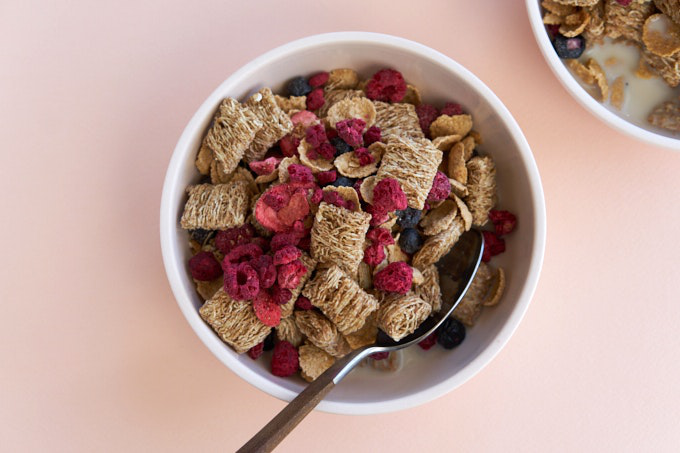


We are often told that breakfast cereal is loaded with essential vitamins and quality nutrition. It is true they are convenient and often taste good, so people rely on cold cereal regularly. The question remains: is cereal good or bad?

It is not a very healthy option.
1. Generally made with ultra-refined grains
Though your box says, ‘made with whole grains’, that is only how they started. The soy, corn or wheat used to grind into your flour has been stripped of any of the health benefits it once had such as fiber and nutrients.
2. High in sugar and calories
Most of the common cereals out there have as much sugar as cookies and donuts. If you’re selecting one of the popular brands, you are packing on calories. One popular brand, thought to be healthy is Kashi Go Lean Crunch. You get 190 calories for a measly ¾ cup serving. Most people eat double that and add milk as well, coming in with at least 450 calories for breakfast that is low in nutritional value.
3. Spike blood sugar and insulin because of high glycemic index
When you consume large amounts of carbohydrates, they get converted into sugar and put back into the blood as fuel or stored as fat. Refined carbohydrates, such as those from flour, are digested and made into sugar quickly. These hit the bloodstream fast, causing a spike in blood sugar. The pancreas reacts by pushing out insulin, the hormone responsible for storing excess fat and regulating blood sugar.
Is cereal bad for you? Eating breakfast cereal can create a vicious cycle of spikes and crashes, creating a craving for high-carb foods. In the long-term, it can increase fat and risk of diabetes.
4. Activate chemicals in the brain to make you feel sedated
Many people buy into the misconception that cereal will give you energy, not true. High carbohydrate foods make you feel sleepy and sedated, due to their stimulation of inhibitory transmitters.
There are foods with high amino acids, such as quality protein, that stimulate your brain to stay vigilant and alert. This means it’s best to eat quality protein for breakfast and processed carbs for dessert. Your first meal will set your neurotransmitters up for the day, while your nighttime snack can set you up for quality sleep.
5. Generally made of wheat, soy or corn
These three ingredients and potatoes comprise more than 50 percent of calories in a Westerner’s diet. Our bodies are not made to digest this much sugar fast. These ingredients are also common sources for allergies. The rise in gluten intolerance is due to modern wheat containing different gluten strains than the heirloom varieties. These strains are causing more allergic reactions.
6. Nutrition is generally only fortified
Is cereal bad for you? Cereal grain is stripped of its nutrients and made into highly processed flour. Then, in order to be a ‘calcium source’ or ‘rich in iron’ chemical versions of minerals and vitamins are added.
7. Protein is low quality
Because the leading ingredient is generally refined grains, or carbs, there aren’t often sources for high quality protein. You will rarely find high-quality protein in the ingredient list and denatured protein is often added. Both Special K Protein and Kashi Go Lean get their protein from Soy Protein Isolate, something people serious about their nutrition wouldn’t ingest. Better options would be pea or whey protein. Soy often has isoflavones, which mess with the body’s estrogen.
Some healthier options include eggs, lean protein like turkey slices or smoked salmon, cottage cheese and Greek yogurt.
Is cereal bad for you? You now have your answer. If you just have to have some cereal, there are a few rules that can help you keep it as healthy as can be.
Opt for less sugar
Read through the nutritional label and choose something with less than 5 grams of sugar a serving. Avoid brands with sugar in the top few ingredients.
Get more fiber
Choose a cereal that has at least three to five grams of fiber in every serving. Fiber is important for gastrointestinal health in children and adults.
Choose whole grains
Cereal with ingredients that have whole grains in the top are preferable. Brands with a Whole Grains Council yellow stamp are better.
Check your serving size
Be mindful of the amount you can eat for the calories and nutritional value. Many people eat more than the recommended serving size so be mindful.
Go through all the ingredients
Read the ingredients and remember they are listed in order of the amount contained in the product, from largest amount to smallest. Be mindful of sugars such as fructose, barley malt and corn syrup.
Add protein
Adding more protein to your breakfast will help control your appetite and keep you full longer. It is thought to be because of its effect on peptide YY and Ghrelin, hormones responsible for appetite.
You can add quality protein with almonds, walnuts, cashews, flax seeds and pumpkin seeds.
Homemade Cereal
Whole-grain cereal such as whole barley or oatmeal may take longer but they will give you the lowest glycemic index. This number illustrates how quickly the carbohydrates are converted to sugar by your body when compared to digesting pure glucose, whose score is 100. If you stick with foods that have less than 55 for their glycemic index number, you will be healthier. You can save those over 70 for special occasions. Oatmeal has a glycemic index of 58 while pearled barley has one of 25, compared to cornflakes with 81, nearly as much as pure glucose.